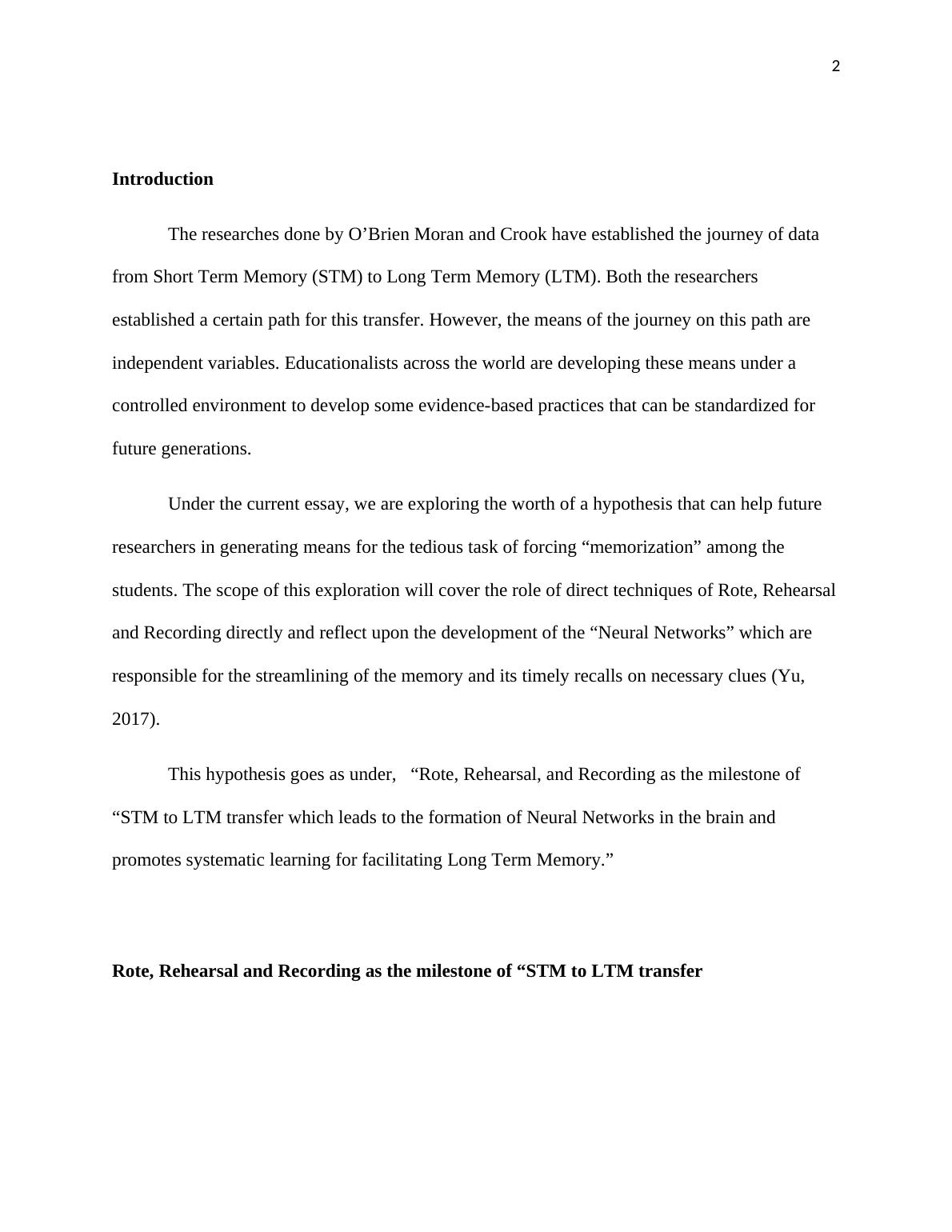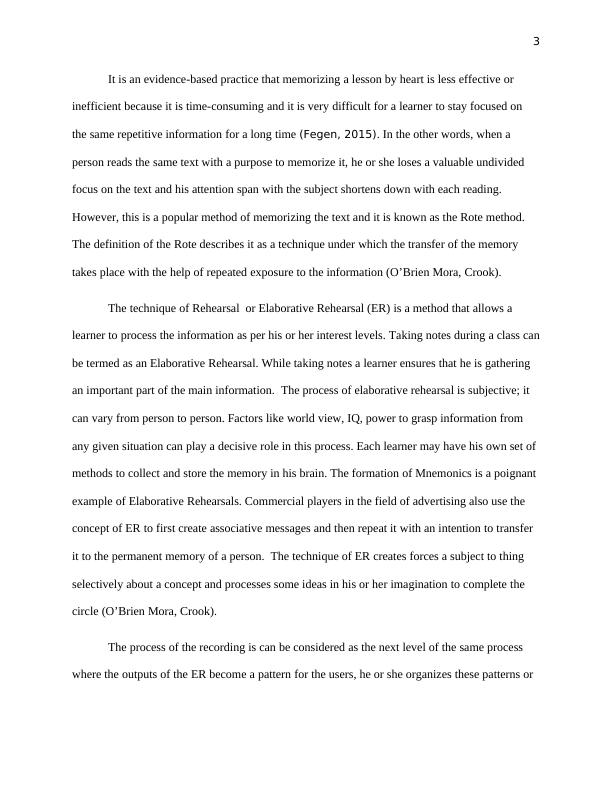Assignment on Short-Term to Long-Term Memory
Added on 2022-08-15
9 Pages2008 Words14 Views
1
Short-Term to Long-Term Memory
Audrey Lei Ramos
University of Manitoba
ARTS 1110: Introduction to University
Dr. Michael O’Brien-Moran
TA: Stephanie Crook
Due: February 6, 2020
1500 words
Essay Number 1
Short-Term to Long-Term Memory
Audrey Lei Ramos
University of Manitoba
ARTS 1110: Introduction to University
Dr. Michael O’Brien-Moran
TA: Stephanie Crook
Due: February 6, 2020
1500 words
Essay Number 1

2
Introduction
The researches done by O’Brien Moran and Crook have established the journey of data
from Short Term Memory (STM) to Long Term Memory (LTM). Both the researchers
established a certain path for this transfer. However, the means of the journey on this path are
independent variables. Educationalists across the world are developing these means under a
controlled environment to develop some evidence-based practices that can be standardized for
future generations.
Under the current essay, we are exploring the worth of a hypothesis that can help future
researchers in generating means for the tedious task of forcing “memorization” among the
students. The scope of this exploration will cover the role of direct techniques of Rote, Rehearsal
and Recording directly and reflect upon the development of the “Neural Networks” which are
responsible for the streamlining of the memory and its timely recalls on necessary clues (Yu,
2017).
This hypothesis goes as under, “Rote, Rehearsal, and Recording as the milestone of
“STM to LTM transfer which leads to the formation of Neural Networks in the brain and
promotes systematic learning for facilitating Long Term Memory.”
Rote, Rehearsal and Recording as the milestone of “STM to LTM transfer
Introduction
The researches done by O’Brien Moran and Crook have established the journey of data
from Short Term Memory (STM) to Long Term Memory (LTM). Both the researchers
established a certain path for this transfer. However, the means of the journey on this path are
independent variables. Educationalists across the world are developing these means under a
controlled environment to develop some evidence-based practices that can be standardized for
future generations.
Under the current essay, we are exploring the worth of a hypothesis that can help future
researchers in generating means for the tedious task of forcing “memorization” among the
students. The scope of this exploration will cover the role of direct techniques of Rote, Rehearsal
and Recording directly and reflect upon the development of the “Neural Networks” which are
responsible for the streamlining of the memory and its timely recalls on necessary clues (Yu,
2017).
This hypothesis goes as under, “Rote, Rehearsal, and Recording as the milestone of
“STM to LTM transfer which leads to the formation of Neural Networks in the brain and
promotes systematic learning for facilitating Long Term Memory.”
Rote, Rehearsal and Recording as the milestone of “STM to LTM transfer

3
It is an evidence-based practice that memorizing a lesson by heart is less effective or
inefficient because it is time-consuming and it is very difficult for a learner to stay focused on
the same repetitive information for a long time (Fegen, 2015). In the other words, when a
person reads the same text with a purpose to memorize it, he or she loses a valuable undivided
focus on the text and his attention span with the subject shortens down with each reading.
However, this is a popular method of memorizing the text and it is known as the Rote method.
The definition of the Rote describes it as a technique under which the transfer of the memory
takes place with the help of repeated exposure to the information (O’Brien Mora, Crook).
The technique of Rehearsal or Elaborative Rehearsal (ER) is a method that allows a
learner to process the information as per his or her interest levels. Taking notes during a class can
be termed as an Elaborative Rehearsal. While taking notes a learner ensures that he is gathering
an important part of the main information. The process of elaborative rehearsal is subjective; it
can vary from person to person. Factors like world view, IQ, power to grasp information from
any given situation can play a decisive role in this process. Each learner may have his own set of
methods to collect and store the memory in his brain. The formation of Mnemonics is a poignant
example of Elaborative Rehearsals. Commercial players in the field of advertising also use the
concept of ER to first create associative messages and then repeat it with an intention to transfer
it to the permanent memory of a person. The technique of ER creates forces a subject to thing
selectively about a concept and processes some ideas in his or her imagination to complete the
circle (O’Brien Mora, Crook).
The process of the recording is can be considered as the next level of the same process
where the outputs of the ER become a pattern for the users, he or she organizes these patterns or
It is an evidence-based practice that memorizing a lesson by heart is less effective or
inefficient because it is time-consuming and it is very difficult for a learner to stay focused on
the same repetitive information for a long time (Fegen, 2015). In the other words, when a
person reads the same text with a purpose to memorize it, he or she loses a valuable undivided
focus on the text and his attention span with the subject shortens down with each reading.
However, this is a popular method of memorizing the text and it is known as the Rote method.
The definition of the Rote describes it as a technique under which the transfer of the memory
takes place with the help of repeated exposure to the information (O’Brien Mora, Crook).
The technique of Rehearsal or Elaborative Rehearsal (ER) is a method that allows a
learner to process the information as per his or her interest levels. Taking notes during a class can
be termed as an Elaborative Rehearsal. While taking notes a learner ensures that he is gathering
an important part of the main information. The process of elaborative rehearsal is subjective; it
can vary from person to person. Factors like world view, IQ, power to grasp information from
any given situation can play a decisive role in this process. Each learner may have his own set of
methods to collect and store the memory in his brain. The formation of Mnemonics is a poignant
example of Elaborative Rehearsals. Commercial players in the field of advertising also use the
concept of ER to first create associative messages and then repeat it with an intention to transfer
it to the permanent memory of a person. The technique of ER creates forces a subject to thing
selectively about a concept and processes some ideas in his or her imagination to complete the
circle (O’Brien Mora, Crook).
The process of the recording is can be considered as the next level of the same process
where the outputs of the ER become a pattern for the users, he or she organizes these patterns or

End of preview
Want to access all the pages? Upload your documents or become a member.
